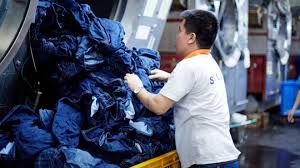(单词翻译:单击)
The perfect pair
完美的牛仔裤
Until the 1970s, a good many jeans sold had been made of stiff, shrink-to-fit—or "unsanforized"—denim. To soften them, you simply had to wear them. A lot. It took a good six months to properly break in jeans. After a couple of years—years—the hems and pocket edges might start to fray, or a knee would split open. The fabric faded to a powdery blue with some whiskering—the sunburst-like streaks that radiate from the fly. Time and dedication were required to push your jeans to peak fabulousness.
直到20世纪70年代,很多出售的牛仔裤都是用坚硬的、经过收缩以适应环境或未经打磨的粗斜纹棉布制成的。要软化它们,只需要穿上身。很多次。我花了整整六个月才把牛仔裤穿得软硬刚好。几年之后,边缘和口袋边缘可能会开始磨损,或者膝盖会裂开。织物褪成了粉末状的蓝色,带着一些拂动——从苍蝇身上放射出的晒斑般的条纹。把你的牛仔裤穿到极致需要时间和投入。
That is, until the popularization of stonewashing in the 1980s. Unsanforized jeans were thrown into industrial washers with pumice stones and tumbled until the denim was sufficiently abraded. (The L.A.-based casualwear company Guess famously had a system that stonewashed jeans for seven hours—a marathon now considered an environmental horror.) Sometimes jeans were further distressed with acid, sandpaper, rasps and files to mimic the previously hard-won wear and tear. The entire operation was christened "finishing" and conducted in "washhouses," sprawling facilities that now process thousands of jeans a day.
直到20世纪80年代石磨的普及。未打磨过的牛仔裤用浮石扔进工业洗衣机里,不断翻滚,直到粗斜纹棉布充分磨损。(洛杉矶总部位于美国的休闲服装公司Guess有一个著名的系统,就是把牛仔裤打磨七个小时——现在看来,这是一场马拉松式的环保灾难。) 有时,牛仔裤还会被酸性物质、砂纸、锉刀和锉刀弄得更旧,以模仿之前的磨损。整个过程被命名为“整理”,在“洗衣房”里进行。洗衣房占地面积很大,如今每天要加工数千条牛仔裤。

Some washhouses—especially those in Los Angeles, America's jeans-finishing center—are highly technical and follow strict worker safety and environmental norms. But a lot do not, as I saw in Ho Chi Minh City on a steamy April morning in 2018.
一些洗衣房——尤其是美国洛杉矶的那些——是高度技术性的,并且严格遵守工人安全和环境规范。但很多都不是这样的,正如2018年4月一个闷热的早晨,我在胡志明市看到的那样。
A largely agrarian economy only 15 years earlier, by 2018, there were roughly 6,000 textile and garment production companies in Vietnam, employing 2.5 million workers, and accounting for about 16 percent of the country's exports and more than $30 billion in revenue. Experts believe that last figure will jump to $50 billion by 2020.
就在15年前,越南还是一个以农业为主的经济体。到2018年,越南大约有6000家纺织和服装生产公司,雇佣了250万名工人,占越南出口的16%左右,收入超过300亿美元。专家认为,到2020年,最后一个数字将跃升至500亿美元。
译文由可可原创,仅供学习交流使用,未经许可请勿转载。


